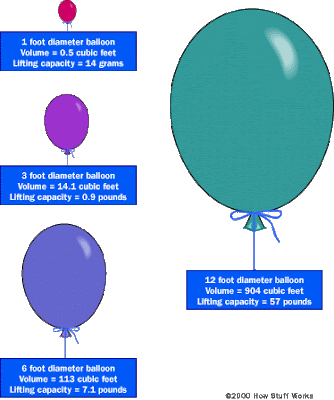
Balloons
If a cork is held below the surface of water and then released it rises. The density of cork is less than that of water, so the weight of water displaced is greater than that of the cork itself. In accordance with Archimedes' principle, the cork is acted upon by a resultant upward force equal to the difference between its own weight and the weight of the water it displaces.
A hydrogen-filled balloon rises in air for precisely thee same reason that the cork rises in water.
The density of air is about 14 times that of hydrogen. The total weight of a balloon consisting of fabric and hydrogen is thus much less than the weight of air it displaces.
The difference between the two represents the useful lifting power of the balloon.
Ships, Cartesian diver and submarines
Bodies which are less dense than water float; those more dense sink. A piece of solid steel sinks, but a ship made of steel floats. Because a ship is hollow and contains air, its average density is less than that of water.

An interesting example of a body whose average density can be varied is the Cartesian diver. This is a small hollow figure made of thin glass and having a hollow, open-ended tail ( as shown in the picture to the right).
Normally, being full of air, it floats on water. If, however, the diver is put inside a bottle full of water with a nicely fitting cork it can be made to sink by pressing in the cork.
Pressure on the cork increases the pressure inside the bottle, with the result that water is forced into the body of the figure through the hollow tail.
The diver then consists of a mixture of glass, water and air. It will sink, remain stationary or rise in the bottle according as to whether its total weight is greater than, equal to or less than the weight of the water it displaces. This video illustrates the Cartesian diver
Similarly, the buoyancy of a submarine depends on the quantity of water in its ballast tanks.
When it is required to dive, water is admitted to special tanks. When the water is ejected from the tanks by means of compressed air the submarine rises to the surface and floats just like any other ship.
Floating bodies

When a piece of wood or other material of density less than that of water is placed in water it sinks until the weight of water displaced is just equal to its own weight. It then floats.
Normally, a hydrogen ( or helium) balloon ascends in still air at a steady rate, but it can be made to float if the quantity of gas it contains is adjusted so that the average density of the balloon is just equal to the density of the surrounding air.
The weight of the displaced air will then be equal to the weight of the balloon.
The above two examples illustrate the law of floatation.
A floating body displaces its own weight of the fluid in which it floats.
It must be understood, however, that this does not express a new principle, but it is merely an expression of Archimedes' principle applied to a special case. I did not forget about the worked example :) it is the next article. See you soon. Good luck.